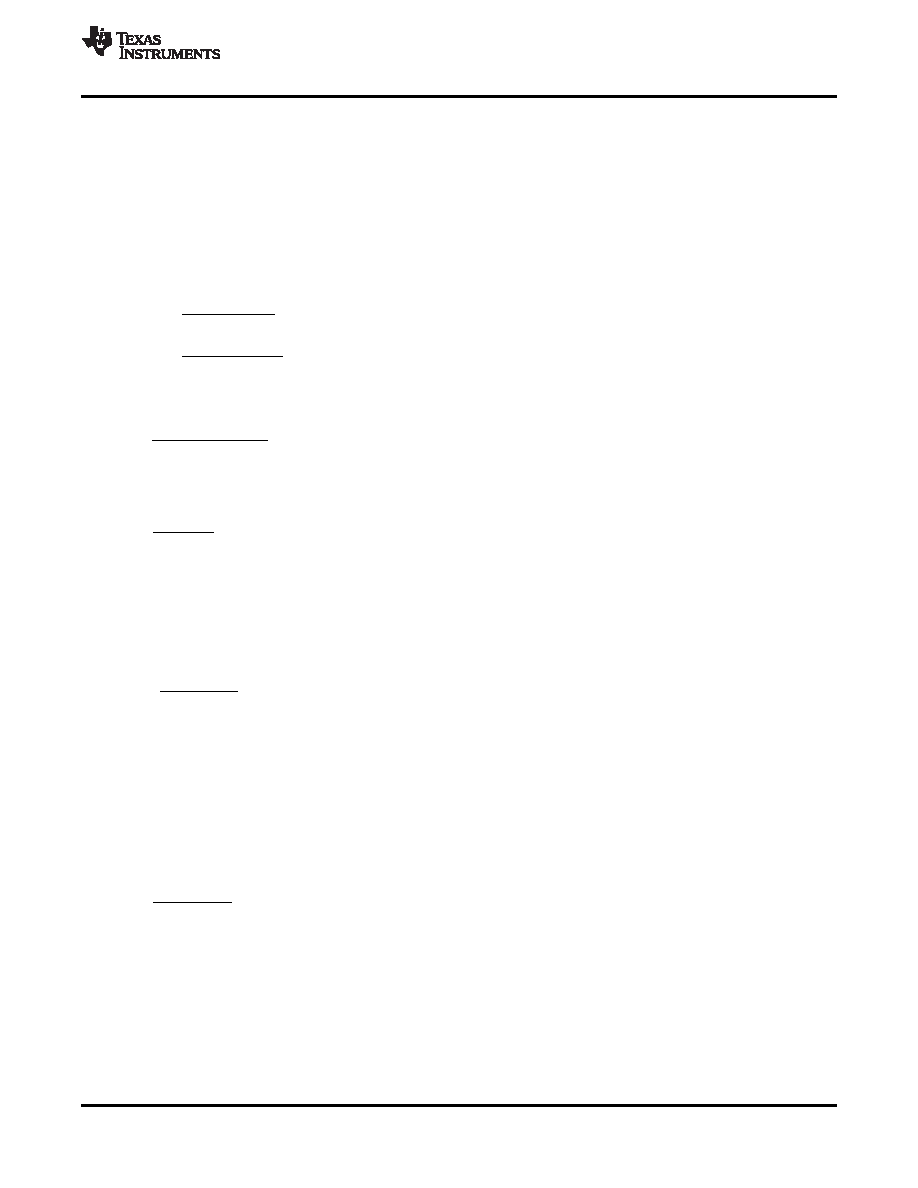- 您現在的位置:買賣IC網 > PDF目錄98282 > TPS54320RHLR (TEXAS INSTRUMENTS INC) SWITCHING REGULATOR, 1320 kHz SWITCHING FREQ-MAX, PQCC14 PDF資料下載
參數資料
| 型號: | TPS54320RHLR |
| 廠商: | TEXAS INSTRUMENTS INC |
| 元件分類: | 穩壓器 |
| 英文描述: | SWITCHING REGULATOR, 1320 kHz SWITCHING FREQ-MAX, PQCC14 |
| 封裝: | 3.50 X 3.50 MM, GREEN, PLASTIC, QFN-14 |
| 文件頁數: | 18/39頁 |
| 文件大小: | 1358K |
| 代理商: | TPS54320RHLR |
第1頁第2頁第3頁第4頁第5頁第6頁第7頁第8頁第9頁第10頁第11頁第12頁第13頁第14頁第15頁第16頁第17頁當前第18頁第19頁第20頁第21頁第22頁第23頁第24頁第25頁第26頁第27頁第28頁第29頁第30頁第31頁第32頁第33頁第34頁第35頁第36頁第37頁第38頁第39頁

2
Iout
pmod
Vout Co
p
=
× ×
×
f
1
2
zmod
RESR Co
p
=
× ×
×
f
2
ea
ps
c Vout Co
R4
gm
Vref gm
p ×
×
=
×
f
Vout Co
C4
Iout R4
×
=
×
1
2
C11
R8
c
p
=
× ×
× f
1
2
p
R4 C6
p
=
× ×
×
f
www.ti.com
SLVS982A – AUGUST 2010 – REVISED SEPTEMBER 2010
Compensation Component Selection
There are several industry techniques used to compensate DC/DC regulators. The method presented here is
easy to calculate and yields high phase margins. For most conditions, the regulator has a phase margin between
60 and 90 degrees. The method presented here ignores the effects of the slope compensation that is internal to
the TPS54320. Since the slope compensation is ignored, the actual crossover frequency is usually lower than the
crossover frequency used in the calculations. Use SwitcherPro software for a more accurate design.
Type III compensation is used to achieve a high bandwidth, high phase margin design. This design targets a
crossover frequency (bandwidth) of 48kHz (1/10th of the switching frequency). Using Equation 32 and
Equation 33, the power stage pole and zero are calculated at 6.46kHz and 1778kHz, respectively. For the output
capacitance, CO, use a derated value of 22.4 F.
(32)
(33)
Now the compensation components can be calculated. First, calculate the value for R4 which sets the gain of the
compensated network at the crossover frequency. Use Equation 34 to determine the value of R4.
(34)
Next calculate the value of C4. Together with R4, C4 places a compensation zero at the modulator pole
frequency. Use Equation 35 to determine the value of C4.
(35)
Using Equation 34 and Equation 35, the standard values for R4 and C4 are 1.78k
and 0.015F. The next
higher standard value for C4 is selected to give a compensation zero that is slightly lower in frequency than the
power stage pole.
In order to provide a zero around the crossover frequency to boost the phase at crossover, a capacitor (C11) is
added parallel to R8. The value of this capacitor is given by Equation 36. The nearest standard value for C11 is
100pF.
(36)
Use of the feedforward capacitor, C11, creates a low AC impedance path from the output voltage to the VSENSE
input of the IC that can couple noise at the switching freqeuncy into the control loop. Use of a feedforward
capacitor is not recommended for high output voltage ripple designs (greater than 15 mV peak to peak at the
VSENSE input) operating at duty cycles of less than 30%. When using the feedforward capacitor, C11, always
limit the closed loop bandwidth to no more than 1/10th of the switching frequency, fsw.
An additional high frequency pole can be used if necessary by adding a capacitor in parallel with the series
combination of R4 and C4. The pole frequency is given by Equation 37. This pole is set at roughly half of the
switching frequency (of 480 kHz) by use of a 330 pF capacitor for C6. This helps attenuate any high frequency
signals that might couple into the control loop.
(37)
Copyright 2010, Texas Instruments Incorporated
25
Product Folder Link(s) :TPS54320
相關PDF資料 |
PDF描述 |
|---|---|
| TPS54320RHL | SWITCHING REGULATOR, PQCC14 |
| TPS54327DDAR | 5.7 A SWITCHING REGULATOR, 700 kHz SWITCHING FREQ-MAX, PDSO8 |
| TPS54328DDA | 5.7 A SWITCHING REGULATOR, 700 kHz SWITCHING FREQ-MAX, PDSO8 |
| TPS54328DDAR | 5.7 A SWITCHING REGULATOR, 700 kHz SWITCHING FREQ-MAX, PDSO8 |
| TPS54331DG4 | 2 A SWITCHING REGULATOR, 684 kHz SWITCHING FREQ-MAX, PDSO8 |
相關代理商/技術參數 |
參數描述 |
|---|---|
| TPS54320RHLT | 功能描述:直流/直流開關調節器 4.5-17V Inp3A Sync Step Down Cnvrtr RoHS:否 制造商:International Rectifier 最大輸入電壓:21 V 開關頻率:1.5 MHz 輸出電壓:0.5 V to 0.86 V 輸出電流:4 A 輸出端數量: 最大工作溫度: 安裝風格:SMD/SMT 封裝 / 箱體:PQFN 4 x 5 |
| TPS54320RHLT | 制造商:Texas Instruments 功能描述:IC SYNC STEP-DOWN CONTROLLER 1.2MHZ Q 制造商:Texas Instruments 功能描述:IC, SYNC STEP-DOWN CONTROLLER, 1.2MHZ, QFN-14 |
| TPS54325 | 制造商:TI 制造商全稱:Texas Instruments 功能描述:4.5-V to 18-V, 3-A OUTPUT SYNCHRONOUS STEP DOWN SWITCHER WITH INTEGRATED FET (SWIFT?) |
| TPS54325_10 | 制造商:TI 制造商全稱:Texas Instruments 功能描述:4.5-V to 18-V, 3-A OUTPUT SYNCHRONOUS STEP DOWN SWITCHER WITH INTEGRATED FET (SWIFT?) |
| TPS54325EVM | 功能描述:電源管理IC開發工具 5-17V Input 3A SWIFT CVTR Eval RoHS:否 制造商:Maxim Integrated 產品:Evaluation Kits 類型:Battery Management 工具用于評估:MAX17710GB 輸入電壓: 輸出電壓:1.8 V |
發布緊急采購,3分鐘左右您將得到回復。